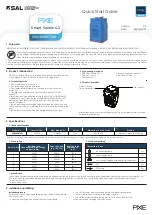
None of the devices assigned to one or more VLANs on an 802.1Q-compliant switch are
being recognized
If multiple VLANs are being used on ports connecting 802.1Q-compliant devices, inconsistent VLAN IDs may
have been assigned to one or more VLANs. For a given VLAN, the same VLAN ID must be used on all connected
802.1Q-compliant devices.
Link configured for multiple VLANs does not support traffic for one or more VLANs
One or more VLANs may not be properly configured as "Tagged" or "Untagged." A VLAN assigned to a port
connecting two 802.1Q-compliant devices must be configured the same on both ports. For example, VLAN_1 and
VLAN_2 use the same link between switch "X" and switch "Y," as shown in
Figure 81: Example: of correct
VLAN port assignments on a link
on page 472.
Figure 81: Example: of correct VLAN port assignments on a link
• If VLAN_1 (VID=1) is configured as "Untagged" on port 3 on switch "X," it must also be configured as
"Untagged" on port 7 on switch "Y." Make sure that the VLAN ID (VID) is the same on both switches.
• Similarly, if VLAN_2 (VID=2) is configured as "Tagged" on the link port on switch "A," it must also be configured
as "Tagged" on the link port on switch "B." Make sure that the VLAN ID (VID) is the same on both switches.
Duplicate MAC addresses across VLANs
The switches operate with multiple forwarding databases. Thus, duplicate MAC addresses occurring on different
VLANs can appear where a device having one MAC address is a member of more than one 802.1Q VLAN, and
the switch port to which the device is linked is using VLANs (instead of MSTP or trunking) to establish redundant
links to another switch. If the other device sends traffic over multiple VLANs, its MAC address consistently
appears in multiple VLANs on the switch port to which it is linked.
Be aware that attempting to create redundant paths through the use of VLANs causes problems with some
switches. One symptom is that a duplicate MAC address appears in the Port Address Table of one port and then
later appears on another port. While the switches have multiple forwarding databases and thus do not have this
problem, some switches with a single forwarding database for all VLANs may produce the impression that a
connected device is moving among ports because packets with the same MAC address but different VLANs are
472
Aruba 2930F / 2930M Management and Configuration Guide
for ArubaOS-Switch 16.08















































